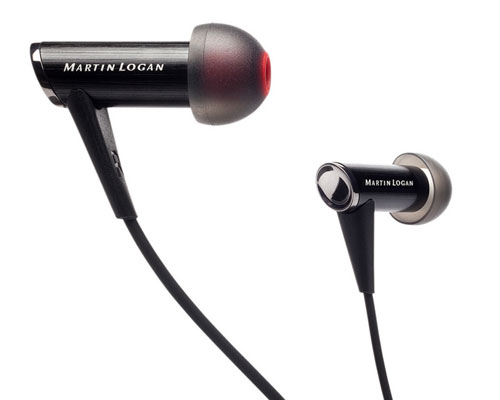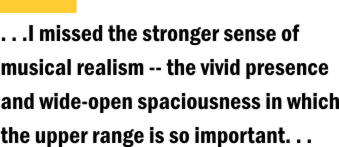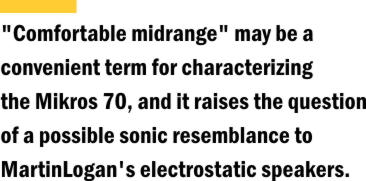MartinLogan • Mikros 70 In-Ear Headphones
statement on the box for the Martin Logan Mikros 70 reads, "Inspired by the clarity and detail of our legendary high-end electrostatic loudspeakers." While that is not the same as declaring that the new in-ear monitor (IEM) is adapted from, or in any sense based on, the design of those famous speakers, it does tie the new product to one of the most respected brands in audio, and one specifically identified with the final step in the delivery of sound.
The physical presentation of the Mikros 70 builds on this identity, while setting up an image of quiet elegance and assurance. The lustrous black box, just large enough for a comfortable layout of its contents, seems to have especially crisp lines and sharp corners, with a bare minimum of labeling, in smallish silver type, and a triangular plastic window showing one of the earpieces and the tiny remote control for designated cyberware. The user’s manual is one of the few I’ve seen with any sort of audio gear that actually mentions the need for burn-in. The term used here is "break in," and the recommendation is for a modest 15 to 30 hours. (I logged nearly 300 hours before getting round to this review.) The Mikros 70’s earpieces resemble the "sound tubes" on B&W’s superb C5, reviewed here in September 2011, though without its positioning loops or vented ends. In place of the straight, cylindrical connectors on the C5 and other IEMs I have used recently, this one has an L-shaped connector, which is a bit easier to handle and tends to enhance the overall impression of solid construction. Five pairs of black vinyl ear-tips are supplied: domelike "buds" in three sizes, and flanged cones in large and small. All are comfortable and easy to change. The cable, like those on several other recently introduced IEMs, is four feet long (1.2 meters) and includes a remote control for the various Apple devices with which it is designed to function. That length is convenient enough for those portable devices, but the additional 12 inches of cable on the benchmark Etymotic Research ER-4S and other IEMs produced strictly for listening to music is an advantage worth mentioning when it comes to using an IEM in a serious indoor audio system. Some preliminary experiments showed that the "default" ear-tips -- medium-sized buds that were in place when I opened the box -- were just snug enough to anchor themselves comfortably in my ears without gratuitously pumping up the bass. The low end, in fact, is comfortably natural, in contradistinction to the hyped-up "rich and creamy" effect that can become amorphous and anti-musical. The Mikros 70 provides pleasant listening.
In my listening tests, perhaps not at all surprisingly, the Mikros 70 performed especially well for chamber music, so much of which lies comfortably within the range best served by it. The Grumiaux Trio’s recording of the variation movement of Mozart’s Divertimento in E-flat, K. 563, for a single violin, viola and cello [Philips 454 023-2] was particularly well served: the occasional rough edge on the 1967 recording was effectively smoothed out without creating a blur, while the full character of Arthur Grumiaux’s violin, on the left, and Georges Janzer’s viola, on the right, were clarified rather than dulled, and Eva Czako’s cello was comfortably in place a little behind Grumiaux. The Hagen Quartet’s peerless performance of the final movement of Haydn’s String Quartet in G minor, Op. 74, No. 3 [Deutsche Grammophon 423 622-2], a later and more agreeably lifelike digital recording, was beautifully in focus, and the first violin’s frequent excursions to its highest reaches presented no problem. Problems did arise, though, in orchestral material, and particularly in works calling for all sections at full strength. Sir Adrian Boult’s definitive 1961 recording, with the London Philharmonic, of the Ballet Music from Holst’s opera The Perfect Fool [Decca 444 549-2], has always been a favorite demo piece, because the music itself is a miniature "concerto for orchestra," giving virtually every instrument or instrumental choir its moment in the spotlight, and Decca came through with one of its best-ever images of real orchestral sound in a good hall. The trombone sound in the opening "Dance of the Spirits of Earth" was both warm and brilliant through the Mikros 70, and the big gesture in the low brass at 2:05 was similarly brilliant, but when the violins soared to the top of their range, about 15 seconds later, what I heard was thinned-out and scrawny, and the sleigh bells and tambourine along the way had to be largely imagined from memory. Next up was the opening section of a different kind of ballet, in a more recent Decca showpiece, Antal Doráti’s 1983 digital recording, with the Detroit SO, of the complete score of Bartók’s music for The Miraculous Mandarin [Decca 411 894-2]. This prefatory section is alive with all sorts of busy and brittle interjections from the winds and brass, and at exactly one minute in, there is a sort of infernal, growling pedal point in the low brasses that can shake the floor. My floor didn’t shake, but the sound had plenty of realistic punch and a sense of limitless depth in its low-end focus. Again and again, as I made my way through more than a dozen other recordings, the impression was that the Mikros 70 is at its best with music that does not extend too far up into the aural stratosphere, and again there was a striking illustration in ballet music. The "Musique des automates" in Delibes’s Coppélia is almost entirely stratospheric, calling for tinkly small percussion, piccolo and violins. This was a sonic showpiece when issued on a monophonic LP in 1955 [RCA Victor LM-2035], and no less a showpiece today for the B&W C5. But the familiar details -- actually the whole point of this piece -- were simply masked or blurred when I listened with the Mikros 70. Similarly, while the other IEMs all very effectively frame a pivotal note from the glockenspiel, with plenty of air around it, in the Beecham recording of Borodin’s Polovtsian Dances [EMI 5 66998 5], the Mikros 70 left me again with the task of filling in from memory. The scherzo in Sir Granville Bantock’s richly colored Pagan Symphony, wonderfully realized by Vernon Handley and the Royal Philharmonic [Hyperion CDA66630], is another brilliant exploitation of the modern orchestra that loses much of its character when the small-percussion details are obscured, as they were in listening with the Mikros 70. Harmonia Mundi’s contemporaneous recording of Chopin’s Étude in C major, Op. 10, No. 1, with Frederic Chiu [Harmonia Mundi HMU 907201], has always struck me as giving an exceptionally realistic sound of the piano itself, which seemed to set the instrument’s innards before us in almost visual detail, hammers, wires, frame and all -- but not this time.
"Comfortable midrange" may be a convenient term for characterizing the Mikros 70, and it raises the question of a possible sonic resemblance to MartinLogan's electrostatic speakers. I'm unable to make a definitive statement here, as I have only limited acquaintance with those speakers, so I will leave that issue for another writer to address. he Mikros 70, like the Paradigm Shift E3m (reviewed
here in April 2012), seems to have been designed for listeners who may prefer the
comfortable cushion of warm sound to the frisson of
the fuller aural image, and I would be the last one to say anyone is "wrong" to
prefer one way of listening to another. The Mikros 70 seems a bit smoother than the E3m,
with a somewhat more natural-sounding low end, and I can imagine that listeners so
disposed would be quite happy with it, but I have to say it is a little short on what may
be expected or demanded by the type of serious listener most likely to read this review.
|
|||||||||||




 he word
"pleasant" is not used here in a pejorative sense, but it may define exactly
what some listeners are after in listening to music, whether out of a wish to avoid a
glaring brightness at the top, or simply an overall preference for warmth over brilliance,
I have to add, however, that with the Mikros 70 I missed the stronger sense of musical
realism -- the vivid presence and wide-open
spaciousness in which the upper range is so important, not only for the occasional ping of a triangle or a skirling piccolo, but for
the fuller definition of the lower instruments as well that comes from opening up the
entire range.
he word
"pleasant" is not used here in a pejorative sense, but it may define exactly
what some listeners are after in listening to music, whether out of a wish to avoid a
glaring brightness at the top, or simply an overall preference for warmth over brilliance,
I have to add, however, that with the Mikros 70 I missed the stronger sense of musical
realism -- the vivid presence and wide-open
spaciousness in which the upper range is so important, not only for the occasional ping of a triangle or a skirling piccolo, but for
the fuller definition of the lower instruments as well that comes from opening up the
entire range. A new
recording of the grandly declamatory opening Allegro of Widor’s Sixth Symphony for
Organ, performed with enthusiasm and authority by William Neil in a live concert on the
splendid instrument at the National Presbyterian Church in Washington [MSR Classics MS
1460], whose sound seemed to come in through one’s very skin as well as one’s
ears when heard with the C5, seemed a little cramped with the Mikros 70, though in Robert
Sharples’s amazing all-out celebration of Albert W. Ketčlbey’s masterwork, the
raucous finale to his Cockney Suite, a
two-minute circus of high spirits bearing the dual title "Bank Holiday (’Appy
’Ampstead)" [Decca 452 987-2], not a single instrument is slighted or fails to
register in full. Much is packed into these two minutes, but hardly any of it goes beyond
what we regard as the comfortable midrange. (Instead of sleigh bells, for instance, this
piece calls for lower-pitched cow bells.) It’s a hoot, and was one of the few
orchestral items I actually enjoyed to the full with the Mikros 70.
A new
recording of the grandly declamatory opening Allegro of Widor’s Sixth Symphony for
Organ, performed with enthusiasm and authority by William Neil in a live concert on the
splendid instrument at the National Presbyterian Church in Washington [MSR Classics MS
1460], whose sound seemed to come in through one’s very skin as well as one’s
ears when heard with the C5, seemed a little cramped with the Mikros 70, though in Robert
Sharples’s amazing all-out celebration of Albert W. Ketčlbey’s masterwork, the
raucous finale to his Cockney Suite, a
two-minute circus of high spirits bearing the dual title "Bank Holiday (’Appy
’Ampstead)" [Decca 452 987-2], not a single instrument is slighted or fails to
register in full. Much is packed into these two minutes, but hardly any of it goes beyond
what we regard as the comfortable midrange. (Instead of sleigh bells, for instance, this
piece calls for lower-pitched cow bells.) It’s a hoot, and was one of the few
orchestral items I actually enjoyed to the full with the Mikros 70.